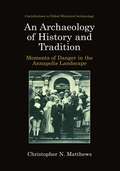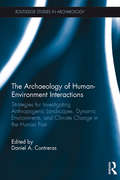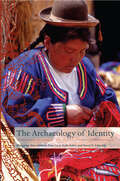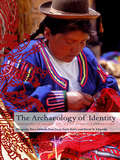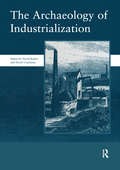- Table View
- List View
The Archaeology of Food and Warfare: Food Insecurity in Prehistory
by Amber M. VanDerwarker Gregory D. WilsonThe archaeologies of food and warfare have independently developed over the past several decades. This volume aims to provide concrete linkages between these research topics through the examination of case studies worldwide. Topics considered within the book include: the impacts of warfare on the daily food quest, warfare and nutritional health, ritual foodways and violence, the provisioning of warriors and armies, status-based changes in diet during times of war, logistical constraints on military campaigns, and violent competition over subsistence resources. The diversity of perspectives included in this volume may be a product of new ways of conceptualizing violence—not simply as an isolated component of a society, nor as an attribute of a particular societal type—but instead as a transformative process that is lived and irrevocably alters social, economic, and political organization and relationships. This book highlights this transformative process by presenting a cross-cultural perspective on the connection between war and food through the inclusion of case studies from several continents.
The Archaeology of Gender: Separating the Spheres in Urban America (Interdisciplinary Contributions to Archaeology)
by Diana diZerga WallHistorical archaeologists often become so involved in their potsherd patterns they seldom have time or energy left to address the broader processes responsi ble for the material culture patterns they recognize. Some ofus haveurged our colleagues to use the historical record as a springboard from which to launch hypotheses with which to better understand the behavioral and cultural pro cesses responsible for the archaeological record. Toooften, this urging has re sulted in reports designed like a sandwich, having a slice of "historical back ground," followed by a totally different "archaeological record," and closed with a weevil-ridden slice of "interpretation" of questionable nutritive value for understanding the past. The reader is often left to wonder what the archae ological meat had to do with either slice of bread, since the connection be tween the documented history and the material culture is left to the reader's imagination, and the connection between the interpretation and the other disparate parts is tenuous at best. The plethora of stale archaeological sandwiches in the literature has re sulted at the methodological level from a too-narrow focus on the specific history and archaeology ofa site and the individuals involvedon it, rather than a focus on the explanation of broader processes of culture to which the actors and events at the site-specific level responded.
The Archaeology of Greater Nicoya: Two Decades of Research in Nicaragua and Costa Rica
by Larry Steinbrenner Alexander Geurds Geoffrey G. McCafferty Silvia SalgadoThe Archaeology of Greater Nicoya is the first edited volume in a quarter century to provide an overview of this fascinating archaeological subarea of Mesoamerica, encompassing Pacific Nicaragua and northwestern Costa Rica. Inhabited by diverse peoples of Mesoamerican origin centuries before Spanish colonization, Greater Nicoya remains controversial in the twenty-first century as scholars struggle to achieve consensus on questions of geography, chronology, and cultural identity. Drawing on approaches ranging from ethnohistory to bioarchaeology to scientific and culture-historical archaeology, the book is organized into sections on redefining Greater Nicoya, projects and surveys, material culture, and mortuary practices. Individual chapters explore Indigenous groups and their origins, extensive summaries of the three largest scholarly archaeological projects completed in Pacific Nicaragua in the last quarter century, clear evidence of Mesoamerican connections from Costa Rica’s Bay of Culebra, detailed histories of lithic analysis and rock art studies in Nicaragua, new insights into mortuary and cultural practices based on osteological evidence, and reinterpretations of diagnostic ceramic types as products of related potting communities and the first definitive identification of production centers for these types. Drawing upon new 14C dates, this volume also provides the most substantial revision of the late pre-colonial chronology since the 1960s, a correction that has critical implications for understanding the prehistory of Greater Nicoya.
An Archaeology of History and Tradition: Moments of Danger in the Annapolis Landscape (Contributions To Global Historical Archaeology)
by Christopher N. MatthewsAs the foundations of the modern world were being laid at the beginning of the 19th century, Annapolis, Maryland, identified itself as the Ancient City. This unusual appellation has served Annapolis into the present as a city that has consistently defined and redefined for itself what being ancient means. The process of historical recognition and preservation that has played out in Annapolis provides valuable insights into the way modern Americans in general have come to know and use the past. Though often conceived to be in opposition, modernity and tradition can be paired as cultural strategies that allow the modern world to be articulated with the tradition it hoped to replace. The multiple histories and historic landscapes derived from archaeological investigations in Annapolis are presented to show that the physical world below the surface of the city has been defined by constructions of modernity in tandem with the survival of certain traditions.
The Archaeology of Household Activities
by Penelope AllisonThis pioneering collection engages with recent research in different areas of the archaeological discipline to bring together case-studies of the household material culture from later prehistoric and classical periods. The book provides a comprehensive and accessible study for students into the material records of past households, aiding wider understanding of our own domestic development.
The Archaeology of Household Activities
by Penelope M. AllisonThis pioneering collection engages with recent research in different areas of the archaeological discipline to bring together case-studies of the household material culture from later prehistoric and classical periods. The book provides a comprehensive and accessible study for students into the material records of past households, aiding wider understanding of our own domestic development.
Archaeology of Households, Kinship, and Social Change (Persistent Questions of the Past)
by Lacey B. CarpenterArchaeology of Households, Kinship, and Social Change offers new perspectives on the processes of social change from the standpoint of household archaeology. This volume develops new theoretical and methodological approaches to the archaeology of households pursuing three critical themes: household diversity in human residential communities with and without archaeologically identifiable houses, interactions within and between households that explicitly considers impacts of kin and non-kin relationships and lastly change as a process that involves the choices made by members of households in the context of larger societal constraints. Encompassing these themes, authors explore the role of social ties and their material manifestations (within the house, dwelling or other constructed space), how the household relates to other social units, how households consolidate power and control over resources, and how these changes manifest at multiple scales. The case studies presented in this volume have broader implications for understanding the drivers of change, the ways households create the contexts for change, and how households serve as spaces for invention, reaction, and/or resistance. Understanding the nature of relationships within households is necessary for a more complete understanding of communities and regions as these ties are vital to explaining how and why societies change. Taking a comparative outlook, with case studies from around the world, this volume will inform students and professionals researching household archaeology and be of interest to other disciplines concerned with the relationship between social networks and societal change.
Archaeology of Households, Kinship, and Social Change (Persistent Questions of the Past)
by Anna Marie Prentiss Lacey B. CarpenterArchaeology of Households, Kinship, and Social Change offers new perspectives on the processes of social change from the standpoint of household archaeology. This volume develops new theoretical and methodological approaches to the archaeology of households pursuing three critical themes: household diversity in human residential communities with and without archaeologically identifiable houses, interactions within and between households that explicitly considers impacts of kin and non-kin relationships and lastly change as a process that involves the choices made by members of households in the context of larger societal constraints. Encompassing these themes, authors explore the role of social ties and their material manifestations (within the house, dwelling or other constructed space), how the household relates to other social units, how households consolidate power and control over resources, and how these changes manifest at multiple scales. The case studies presented in this volume have broader implications for understanding the drivers of change, the ways households create the contexts for change, and how households serve as spaces for invention, reaction, and/or resistance. Understanding the nature of relationships within households is necessary for a more complete understanding of communities and regions as these ties are vital to explaining how and why societies change. Taking a comparative outlook, with case studies from around the world, this volume will inform students and professionals researching household archaeology and be of interest to other disciplines concerned with the relationship between social networks and societal change.
The Archaeology Of Human Bones
by Simon MaysThe Archaeology of Human Bonesprovides an up to date account of the scientific analysis of human skeletal remains from archaeological sites. This completely revised edition reflects the latest developments in scientific techniques for studying human skeletons and the latest applications of those techniques in archaeology. In particular, the sections on ancient DNA and bone stable isotopes have been comprehensively updated, and two completely new chapters have been introduced, covering metric study of the postcranial skeleton and ethical dimensions of the study of human remains. The Archaeology of Human Bonesintroduces students to the anatomy of bones and teeth, utilising a large number of images. It analyzes the biasing effects of decay and incomplete recovery on burial data from archaeological sites, and discusses what we may learn about burial rites from human remains. Subsequent chapters focus on demographic analysis of earlier populations, normal skeletal variation, disease and injury, isotopic and DNA analysis of bone, the study of cremated bone and ethical aspects of working with ancient human remains. Current scientific methods are explained, alongside a critical discussion of their strengths and weaknesses. The ways in which scientific analyses of human skeletal remains can contribute to tackling major archaeological or historical issues is illustrated by means of examples drawn from studies from around the world. Technical jargon is kept to a minimum, and each chapter contains a summary of the main points that a student should grasp and a list of further reading targeted to enable students to follow up major issues covered in the book. Featuring case studies from around the world and with copious illustrations, The Archaeology of Human Bonescontinues to be a crucial work for students of archaeology.
The Archaeology of Human Bones
by Simon MaysThe Archaeology of Human Bones provides an up to date account of the scientific analysis of human skeletal remains from archaeological sites. This completely revised edition reflects the latest developments in scientific techniques for studying human skeletons and the latest applications of those techniques in archaeology. In particular, the sections on ancient DNA and bone stable isotopes have been comprehensively updated, and two completely new chapters have been introduced, covering metric study of the postcranial skeleton and ethical dimensions of the study of human remains. The Archaeology of Human Bones introduces students to the anatomy of bones and teeth, utilising a large number of images. It analyzes the biasing effects of decay and incomplete recovery on burial data from archaeological sites, and discusses what we may learn about burial rites from human remains. Subsequent chapters focus on demographic analysis of earlier populations, normal skeletal variation, disease and injury, isotopic and DNA analysis of bone, the study of cremated bone and ethical aspects of working with ancient human remains. Current scientific methods are explained, alongside a critical discussion of their strengths and weaknesses. The ways in which scientific analyses of human skeletal remains can contribute to tackling major archaeological or historical issues is illustrated by means of examples drawn from studies from around the world. Technical jargon is kept to a minimum, and each chapter contains a summary of the main points that a student should grasp and a list of further reading targeted to enable students to follow up major issues covered in the book. Featuring case studies from around the world and with copious illustrations, The Archaeology of Human Bones continues to be a crucial work for students of archaeology.
The Archaeology of Human Bones
by Simon MaysThe Archaeology of Human Bones provides an up to date account of the scientific analysis of human skeletal remains from archaeological sites. This completely revised edition reflects the latest developments in scientific techniques for studying human skeletons and the latest applications of those techniques in archaeology. In particular, the sections on ancient DNA and bone stable isotopes have been comprehensively updated, and two completely new chapters have been introduced, covering metric study of the postcranial skeleton and ethical dimensions of the study of human remains. The Archaeology of Human Bones introduces students to the anatomy of bones and teeth, utilising a large number of images. It analyzes the biasing effects of decay and incomplete recovery on burial data from archaeological sites, and discusses what we may learn about burial rites from human remains. Subsequent chapters focus on demographic analysis of earlier populations, normal skeletal variation, disease and injury, isotopic and DNA analysis of bone, the study of cremated bone and ethical aspects of working with ancient human remains. Current scientific methods are explained, alongside a critical discussion of their strengths and weaknesses. The ways in which scientific analyses of human skeletal remains can contribute to tackling major archaeological or historical issues is illustrated by means of examples drawn from studies from around the world. Technical jargon is kept to a minimum, and each chapter contains a summary of the main points that a student should grasp and a list of further reading targeted to enable students to follow up major issues covered in the book. Featuring case studies from around the world and with copious illustrations, The Archaeology of Human Bones continues to be a crucial work for students of archaeology.
The Archaeology of Human Bones
by Simon MaysThe Archaeology of Human Bones provides an up to date account of the analysis of human skeletal remains from archaeological sites, introducing students to the anatomy of bones and teeth and the nature of the burial record. Drawing from studies around the world, this book illustrates how the scientific study of human remains can shed light upon important archaeological and historical questions. This new edition reflects the latest developments in scientific techniques and their application to burial archaeology. Current scientific methods are explained, alongside a critical consideration of their strengths and weaknesses. The book has also been thoroughly revised to reflect changes in the ways in which scientific studies of human remains have influenced our understanding of the past, and has been updated to reflect developments in ethical debates that surround the treatment of human remains. There is now a separate chapter devoted to archaeological fieldwork on burial grounds, and the chapters on DNA and ethics have been completely rewritten. This edition of The Archaeology of Human Bones provides not only a more up to date but also a more comprehensive overview of this crucial area of archaeology. Written in a clear style with technical jargon kept to a minimum, it continues to be a key work for archaeology students.
The Archaeology of Human Bones
by Simon MaysThe Archaeology of Human Bones provides an up to date account of the analysis of human skeletal remains from archaeological sites, introducing students to the anatomy of bones and teeth and the nature of the burial record. Drawing from studies around the world, this book illustrates how the scientific study of human remains can shed light upon important archaeological and historical questions. This new edition reflects the latest developments in scientific techniques and their application to burial archaeology. Current scientific methods are explained, alongside a critical consideration of their strengths and weaknesses. The book has also been thoroughly revised to reflect changes in the ways in which scientific studies of human remains have influenced our understanding of the past, and has been updated to reflect developments in ethical debates that surround the treatment of human remains. There is now a separate chapter devoted to archaeological fieldwork on burial grounds, and the chapters on DNA and ethics have been completely rewritten. This edition of The Archaeology of Human Bones provides not only a more up to date but also a more comprehensive overview of this crucial area of archaeology. Written in a clear style with technical jargon kept to a minimum, it continues to be a key work for archaeology students.
The Archaeology Of Human Bones (PDF)
by Simon MaysThe Archaeology of Human Bonesprovides an up to date account of the scientific analysis of human skeletal remains from archaeological sites. This completely revised edition reflects the latest developments in scientific techniques for studying human skeletons and the latest applications of those techniques in archaeology. In particular, the sections on ancient DNA and bone stable isotopes have been comprehensively updated, and two completely new chapters have been introduced, covering metric study of the postcranial skeleton and ethical dimensions of the study of human remains. The Archaeology of Human Bonesintroduces students to the anatomy of bones and teeth, utilising a large number of images. It analyzes the biasing effects of decay and incomplete recovery on burial data from archaeological sites, and discusses what we may learn about burial rites from human remains. Subsequent chapters focus on demographic analysis of earlier populations, normal skeletal variation, disease and injury, isotopic and DNA analysis of bone, the study of cremated bone and ethical aspects of working with ancient human remains. Current scientific methods are explained, alongside a critical discussion of their strengths and weaknesses. The ways in which scientific analyses of human skeletal remains can contribute to tackling major archaeological or historical issues is illustrated by means of examples drawn from studies from around the world. Technical jargon is kept to a minimum, and each chapter contains a summary of the main points that a student should grasp and a list of further reading targeted to enable students to follow up major issues covered in the book. Featuring case studies from around the world and with copious illustrations, The Archaeology of Human Bonescontinues to be a crucial work for students of archaeology.
The Archaeology of Human-Environment Interactions: Strategies for Investigating Anthropogenic Landscapes, Dynamic Environments, and Climate Change in the Human Past (Routledge Studies in Archaeology)
by Daniel ContrerasThe impacts of climate change on human societies, and the roles those societies themselves play in altering their environments, appear in headlines more and more as concern over modern global climate change intensifies. Increasingly, archaeologists and paleoenvironmental scientists are looking to evidence from the human past to shed light on the processes which link environmental and cultural change. Establishing clear contemporaneity and correlation, and then moving beyond correlation to causation, remains as much a theoretical task as a methodological one. This book addresses this challenge by exploring new approaches to human-environment dynamics and confronting the key task of constructing arguments that can link the two in concrete and detailed ways. The contributors include researchers working in a wide variety of regions and time periods, including Mesoamerica, Mongolia, East Africa, the Amazon Basin, and the Island Pacific, among others. Using methodological vignettes from their own research, the contributors explore diverse approaches to human-environment dynamics, illustrating the manifold nature of the subject and suggesting a wide variety of strategies for approaching it. This book will be of interest to researchers and scholars in Archaeology, Paleoenvironmental Science, Ecology, and Geology.
The Archaeology of Human-Environment Interactions: Strategies for Investigating Anthropogenic Landscapes, Dynamic Environments, and Climate Change in the Human Past (Routledge Studies in Archaeology)
by Daniel A. ContrerasThe impacts of climate change on human societies, and the roles those societies themselves play in altering their environments, appear in headlines more and more as concern over modern global climate change intensifies. Increasingly, archaeologists and paleoenvironmental scientists are looking to evidence from the human past to shed light on the processes which link environmental and cultural change. Establishing clear contemporaneity and correlation, and then moving beyond correlation to causation, remains as much a theoretical task as a methodological one. This book addresses this challenge by exploring new approaches to human-environment dynamics and confronting the key task of constructing arguments that can link the two in concrete and detailed ways. The contributors include researchers working in a wide variety of regions and time periods, including Mesoamerica, Mongolia, East Africa, the Amazon Basin, and the Island Pacific, among others. Using methodological vignettes from their own research, the contributors explore diverse approaches to human-environment dynamics, illustrating the manifold nature of the subject and suggesting a wide variety of strategies for approaching it. This book will be of interest to researchers and scholars in Archaeology, Paleoenvironmental Science, Ecology, and Geology.
The Archaeology of Identities: A Reader
by Timothy InsollThe Archaeology of Identities brings together seventeen seminal articles from this exciting new discipline in one indispensable volume for the first time. Editor Timothy Insoll expertly selects a cross-section of contributions by leading authorities to form a comprehensive and balanced representation of approaches and interests. Issues covered include: gender and sexuality ethnicity, nationalism and caste age ideology disability. Chapters are thematically arranged and are contextualized with lucid summaries and an introductory chapter, providing an accessible introduction to the varied selection of case studies included and archaeological materials considered from global sources. The study of identity is increasingly recognized as a fundamental division of archaeological enquiry, and has recently become the focus of a variety of new and challenging developments. As such, this volume will fast become the definitive sourcebook in archaeology of identities, making it essential reading for students, lecturers and researchers in the field.
The Archaeology of Identities: A Reader
by Timothy InsollThe Archaeology of Identities brings together seventeen seminal articles from this exciting new discipline in one indispensable volume for the first time. Editor Timothy Insoll expertly selects a cross-section of contributions by leading authorities to form a comprehensive and balanced representation of approaches and interests. Issues covered include: gender and sexuality ethnicity, nationalism and caste age ideology disability. Chapters are thematically arranged and are contextualized with lucid summaries and an introductory chapter, providing an accessible introduction to the varied selection of case studies included and archaeological materials considered from global sources. The study of identity is increasingly recognized as a fundamental division of archaeological enquiry, and has recently become the focus of a variety of new and challenging developments. As such, this volume will fast become the definitive sourcebook in archaeology of identities, making it essential reading for students, lecturers and researchers in the field.
Archaeology of Identity
by Margarita Diaz-Andreu Sam LucyBringing together a wealth of scholarship which provides a unique integrated approach to identity, The Archaeology of Identity presents an overview of the five key areas which have recently emerged in archaeological social theory: * gender* age* ethnicity* religion * status. This excellent book reviews the research history of each areas, the different ways in which each has been investigated, and offers new avenues for research and exploring the connections between them. Emphasis is placed on exploring the ways in which material culture structures, and is structured by, these aspects of individual and communal identity, with a particular examination of social practice. Useful for social scientists in sociology, anthropology and history, under- and postgraduates will find this an excellent addition to their course studies.
Archaeology of Identity
by Margarita Diaz-Andreu Sam LucyBringing together a wealth of scholarship which provides a unique integrated approach to identity, The Archaeology of Identity presents an overview of the five key areas which have recently emerged in archaeological social theory: * gender* age* ethnicity* religion * status. This excellent book reviews the research history of each areas, the different ways in which each has been investigated, and offers new avenues for research and exploring the connections between them. Emphasis is placed on exploring the ways in which material culture structures, and is structured by, these aspects of individual and communal identity, with a particular examination of social practice. Useful for social scientists in sociology, anthropology and history, under- and postgraduates will find this an excellent addition to their course studies.
An Archaeology of Identity: Soldiers and Society in Late Roman Britain (UCL Institute of Archaeology Publications)
by Andrew GardnerWhat happened to Roman soldiers in Britain during the decline of the empire in the 4th and 5th centuries? Did they withdraw, defect, or go native? More than a question of military history, this is the starting point for Andrew Gardner’s incisive exploration of social identity in Roman Britain, in the Roman Empire, and in ancient society. Drawing on the sociological theories of Anthony Giddens and others, Gardner shapes an approach that focuses on the central role of practice in the creation and maintenance of identities—nationalist, gendered, class, and ethnic. This theory is then tested against the material remains of Roman soldiers in Britain to show how patterning of stratigraphy, architecture, and artifacts supports his theoretical construct. The result is a retelling of the story of late Roman Britain sharply at odds with the traditional text-driven histories and a theory of human action that offers much to current debates across the social sciences.
An Archaeology of Identity: Soldiers and Society in Late Roman Britain (UCL Institute of Archaeology Publications)
by Andrew GardnerWhat happened to Roman soldiers in Britain during the decline of the empire in the 4th and 5th centuries? Did they withdraw, defect, or go native? More than a question of military history, this is the starting point for Andrew Gardner’s incisive exploration of social identity in Roman Britain, in the Roman Empire, and in ancient society. Drawing on the sociological theories of Anthony Giddens and others, Gardner shapes an approach that focuses on the central role of practice in the creation and maintenance of identities—nationalist, gendered, class, and ethnic. This theory is then tested against the material remains of Roman soldiers in Britain to show how patterning of stratigraphy, architecture, and artifacts supports his theoretical construct. The result is a retelling of the story of late Roman Britain sharply at odds with the traditional text-driven histories and a theory of human action that offers much to current debates across the social sciences.
An Archaeology of Improvement in Rural Massachusetts: Landscapes of Profit and Betterment at the Dawn of the 19th century (Contributions To Global Historical Archaeology)
by Quentin LewisThis book probes the materiality of Improvement in early 19th century rural Massachusetts. Improvement was a metaphor for human intervention in the dramatic changes taking place to the English speaking world in the 18th and 19th centuries as part of a transition to industrial capitalism. The meaning of Improvement vacillated between ideas of economic profit and human betterment, but in practice, Improvement relied on a broad assemblage of material things and spaces for coherence and enaction. Utilizing archaeological data from the home of a wealthy farmer in rural Western Massachusetts, as well as an analysis of early Republican agricultural publications, this book shows how Improvement’s twin meanings of profit and betterment unfolded unevenly across early 19th century New England. The Improvement movement in Massachusetts emerged at a time of great social instability, and served to ameliorate growing tensions between urban and rural socioeconomic life through a rationalization of space. Alongside this rationalization, Improvement also served to reshape rural landscapes in keeping with the social and economic processes of a modernizing global capitalism. But the contradictions inherent in such processes spurred and buttressed wealth inequality, ecological distress, and social dislocation.
The Archaeology of Industrialization: Society of Post-Medieval Archaeology Monographs
by David Barker David CranstoneThis book is the outcome of the first joint conference of the two country's foremost societies devoted to the archaeological study of the early-modern and modern worlds. It discusses the progress of industrialization and its impact upon modern society.
The Archaeology of Industrialization: Society of Post-Medieval Archaeology Monographs
by David Barker David CranstoneThis book is the outcome of the first joint conference of the two country's foremost societies devoted to the archaeological study of the early-modern and modern worlds. It discusses the progress of industrialization and its impact upon modern society.



